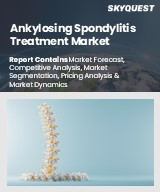
강직성 척추염 치료 세계 시장 규모는 2023년에 31억 달러, 2024년 33억 4,000만 달러에서 2032년에는 60억 9,000만 달러로 확대되어 예측 기간(2025-2032년) CAGR은 7.8%를 나타낼 전망입니다.
특히 청년 및 중장년층의 강직성 척추염(AS) 유병률 증가가 시장 확대에 큰 영향을 미치고 있습니다. 척추와 천장관절에 심각한 영향을 미치는 자가면역성 만성질환인 AS는 HLA-B27 유전자와 같은 유전적 요인이 주요 원인이며, 특히 유럽, 북미, 아시아 일부 지역 등에서 유행하고 있습니다. 인지도와 진단 능력이 향상됨에 따라 조기 진단을 통한 장기적인 관리와 혁신적인 치료법에 대한 수요가 증가하고 있습니다. 생물학적 치료, 특히 종양괴사인자(TNF) 억제제와 인터루킨-17(IL-17) 차단제는 염증 경로를 특이적으로 표적으로 삼을 수 있다는 장점으로 인해 선호되는 치료법이 되고 있습니다. 현재 진행 중인 연구 개발은 차세대 생물학적 제제 개발을 목표로 하고 있으며, 이는 치료 옵션에서 생물학적 제제의 중요한 역할을 강화하고 시장 성장을 가속하고 있습니다.
Global Ankylosing Spondylitis Treatment Market size was valued at USD 3.1 billion in 2023 and is poised to grow from USD 3.34 billion in 2024 to USD 6.09 billion by 2032, growing at a CAGR of 7.8% during the forecast period (2025-2032).
The rising prevalence of ankylosing spondylitis (AS), particularly among young and middle-aged adults, is significantly influencing market expansion. AS, an autoimmune chronic disorder that severely impacts the spine and sacroiliac joints, is predominantly driven by genetic factors such as the HLA-B27 gene, especially prevalent in regions like Europe, North America, and parts of Asia. As awareness and diagnostic capabilities improve, earlier diagnoses lead to an increased demand for long-term management and innovative treatments. Biologic therapies, notably tumor necrosis factor (TNF) inhibitors and interleukin-17 (IL-17) blockers, are becoming the preferred choice due to their ability to specifically target inflammation pathways. Ongoing research aims to develop next-generation biologics, reinforcing their critical role in therapeutic options and catalyzing market growth.
Top-down and bottom-up approaches were used to estimate and validate the size of the Global Ankylosing Spondylitis Treatment market and to estimate the size of various other dependent submarkets. The research methodology used to estimate the market size includes the following details: The key players in the market were identified through secondary research, and their market shares in the respective regions were determined through primary and secondary research. This entire procedure includes the study of the annual and financial reports of the top market players and extensive interviews for key insights from industry leaders such as CEOs, VPs, directors, and marketing executives. All percentage shares split, and breakdowns were determined using secondary sources and verified through Primary sources. All possible parameters that affect the markets covered in this research study have been accounted for, viewed in extensive detail, verified through primary research, and analyzed to get the final quantitative and qualitative data.
Global Ankylosing Spondylitis Treatment Market Segments Analysis
Global Ankylosing Spondylitis Treatment Market is segmented by Treatment Type, Drug Type, End-User and region. Based on Treatment Type, the market is segmented into NSAIDs (Non-Steroidal Anti-Inflammatory Drugs), Biologics (TNF Inhibitors, IL-17 Inhibitors), DMARDs (Disease-Modifying Anti-Rheumatic Drugs), Physical Therapy & Exercise and Others. Based on Drug Type, the market is segmented into Branded Drugs and Generic Drugs. Based on End-User, the market is segmented into Hospitals & Clinics, Specialty Clinics and Home Care. Based on region, the market is segmented into North America, Europe, Asia Pacific, Latin America and Middle East & Africa.
Driver of the Global Ankylosing Spondylitis Treatment Market
The rising global incidence of ankylosing spondylitis, especially in younger demographics, serves as a significant catalyst for the market. As more individuals receive a diagnosis, there is a growing need for effective treatment options. In response to this surge in therapeutic requirements, healthcare systems and pharmaceutical companies are dedicating increased resources to the development of innovative drugs, advanced diagnostic tools, and patient-centered care approaches. This trend highlights the urgency to meet the evolving needs of patients suffering from ankylosing spondylitis, further stimulating market growth and fostering advancements in treatment solutions.
Restraints in the Global Ankylosing Spondylitis Treatment Market
The Global Ankylosing Spondylitis Treatment market faces significant restraints, particularly in emerging markets where a lack of general practitioner awareness and low patient knowledge lead to delayed diagnoses of this condition. Such delays can result in advanced disease progression and reduced effectiveness of treatment options. Furthermore, the shortage of skilled rheumatologists and the absence of comprehensive initial screening programs exacerbate these challenges, ultimately hindering overall market growth. Addressing these barriers is essential to enhance early detection and ensure optimal management of ankylosing spondylitis, thereby improving patient outcomes and stimulating market development.
Market Trends of the Global Ankylosing Spondylitis Treatment Market
The Global Ankylosing Spondylitis Treatment market is witnessing a significant trend towards biologics, particularly TNF and IL-17 inhibitors, which are redefining therapeutic approaches due to their targeted mechanisms and improved efficacy. This shift is propelled by robust ongoing research and development, coupled with the expansion of biosimilar options, making these advanced therapies more accessible and cost-effective. As healthcare providers and patients seek long-term disease control and enhanced quality of life, the preference for biologic treatments continues to solidify, stimulating market growth. This transition underscores the evolving landscape of ankylosing spondylitis management and underscores the importance of innovation in therapeutic regimens.